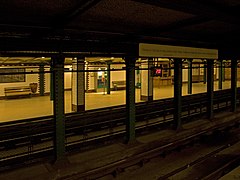Bajcsy-Zsilinszky út metro station
Bajcsy-Zsilinszky út | |||||||||||
|---|---|---|---|---|---|---|---|---|---|---|---|
| Budapest Metro station | |||||||||||
 Station entrance from Andrássy Avenue | |||||||||||
| General information | |||||||||||
| Location | Budapest Hungary | ||||||||||
| Coordinates | 47°29′58″N 19°03′18″E / 47.4994°N 19.055°E | ||||||||||
| Platforms | 2 side platforms | ||||||||||
| Construction | |||||||||||
| Structure type | cut-and-cover underground | ||||||||||
| History | |||||||||||
| Opened | 2 May 1896 | ||||||||||
| Rebuilt | 1970 | ||||||||||
| Services | |||||||||||
| |||||||||||
Bajcsy-Zsilinszky út is a station of the yellow M1 (Millennium Underground) line of the Budapest Metro. It is situated under Andrássy Avenue close to its junction with Bajcsy-Zsilinszky street. It was formerly named Váczy körút station.
The station was opened on 2 May 1896 as part of the inaugural section of the Budapest Metro, between Vörösmarty tér and Széchenyi fürdő.[1] This section, known as the Millennium Underground Railway, was the first metro system in continental Europe. In 2002, it was included into the World Heritage Site "Budapest, including the Banks of the Danube, the Buda Castle Quarter and Andrássy Avenue".[2]
The station is named after Endre Bajcsy-Zsilinszky a member of the Independent Smallholders, Agrarian Workers and Civic Party and leader of the resistance who was executed toward the end of the Second World War.
The station has two side platforms, each with its own independent access from the street.
- Interior with station manager's office
- Platforms and rails
- The station platforms
- Entrance at night
Connections
- Bus: 9, 105, 210, 210B
References
- ^ Schwandl, Robert. "Budapest". urbanrail.
- ^ "Budapest, including the Banks of the Danube, the Buda Castle Quarter and Andrássy Avenue". UNESCO.





